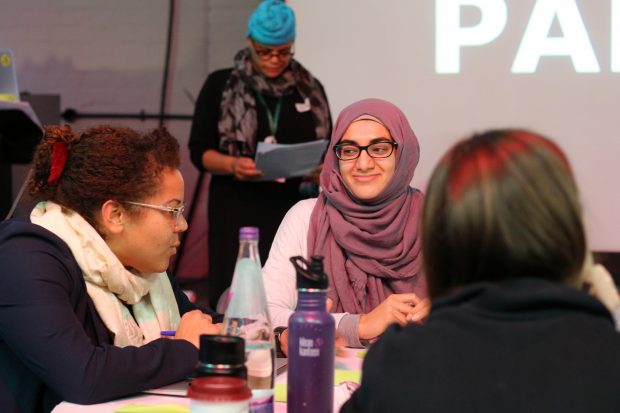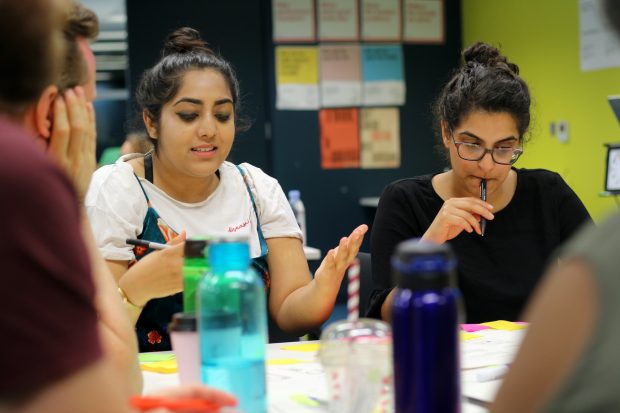
The GDS design team is not equitable enough. This means some people face more barriers than others in the workplace because of their characteristics or the groups they are a part of. These people are less privileged and have less power than others and we are all responsible for rebalancing the spread of power. Members of our team feel or have felt excluded or marginalised. We want to do better.
We are purposefully choosing to talk about ‘equity’. Dr Nisreen Alwan’s tweet explains why this is important:
I wish we can replace the use of ‘diversity’ & ‘inclusion’ with ‘equity’ instead. Words matter. The first two imply charity from a position of power. Opening the door to ‘diversify’ & ‘include’ still means you hold the key. There shouldn’t be one, that’s the point.
— Prof Nisreen Alwan 🌻 (@Dr2NisreenAlwan) December 17, 2019
We are working on this in the spirit of this message from @TatianaTMac:
“Your privilege is not your fault, but it is your responsibility.” @TatianaTMac #Clarity2019 pic.twitter.com/Hx39iYccrd
— Yesenia Perez-Cruz (@yeseniaa) August 21, 2019
In a previous blog post we wrote about our team lacking diversity. Now we are sharing what we are doing to increase equity in the team.
Being more open about our lack of equity and what we’re doing to rebalance
We believe that talking about the problems we’re facing is important because it helps us stay transparent and accountable. We want people inside and outside GDS to know that we care about these issues and want to do something about them. We hope to get feedback and learn from other people who are doing similar work. We are talking more openly about equity in the design team and across GDS. Externally, we are tweeting about it and writing this series of blog posts. We also meet fortnightly to review and rethink this work.
Responding to feedback
All of this work has been the result of responding to incredibly important criticism and guidance. This has come from inside and outside our team. We owe a huge amount to Debs Durojaiye, who is currently on a career break from our team, for helping us with this.
Mapping the journey of designers applying, joining and working at GDS
We've been interviewing designers in GDS to understand advantages or disadvantages people might face when being part of the design community. We’ll write an update about this in another blog post.
Researching blockers to hiring junior and mid-level designers
We know that hiring at more senior levels excludes candidates who might not have studied design, or been to university. This increases the chances of groupthink. We want to understand why multi-disciplinary teams aren’t seeking juniors, and what we need to do to properly support juniors. We hope to write more in another blog post.
Running a training course called ‘Power and privilege in design’
Sonia Turcotte from Citizens Advice and Clara have developed a training course to help user-centred design practitioners in GDS. Our aim is to increase the understanding of how power, privilege, and structural oppression impact their design practices, outputs, and the services we deliver. We hope to run the session regularly.
Mentoring people from underrepresented groups
We support GDS designers to become mentors to less experienced designers from underrepresented groups. We hope to help mentees with their career goals and confidence. We also want to give mentors a better understanding of marginalisation in the design industry. To support first-time mentors, we’ve established partnerships. Rahma Mohamed from Hackney City Council is helping us learn from a pilot we ran with their apprentices. One Million Mentors (1MM) are providing training for mentors and mentees. If we meet our objectives, we hope to support designers across government to become mentors.
Improving job descriptions
We have reviewed the language and requirements in our job descriptions, to ensure we’re not needlessly excluding people. We continue to iterate and improve them where we can.
Increasing awareness and reach of our recruitment campaigns
Many people in the GDS design team had a connection to the design team before they joined - they had worked with someone in the team before, had a friend of a friend, or had met someone at an event. We’re trying to make this more equitable by building connections with people outside of our social and professional networks.
We promote vacant positions to groups and people who can help us reach audiences with greater diversity. We have attended industry events like Mozfest, Silicon milkroundabout, and the Service Design Fringe Festival, where the attendees better represent the diverse population of London.
Running careers evenings for people from underrepresented groups
We are running a careers evening for people in underrepresented groups on Thursday 27 February, with the hope encouraging people from underrepresented groups to apply for roles at GDS. We ran a similar event in December 2019. At these events, attendees have time to chat with designers and user researchers at GDS and see presentations on what GDS is, what UCD is, what it’s like working as a UCD practitioner in government, and how to apply for a job in government. We plan to run this event again in the future, and to help other GDS and cross-government communities run similar events.
Running training exclusively for people from underrepresented groups
The ‘Introduction to service design’ training is usually sold out within hours of release. We know it can take longer for information about our courses to reach underrepresented groups. To counter this we regularly run the course just for people from these groups. We also reserve tickets for people from these groups on most of our courses. We collect information about the attendees of our courses to monitor demographics over time. We do this to equalise the opportunities for people from underrepresented groups to find out about service design and working in design in government.

Making weekly design team meetings more inclusive
We conducted research with designers to learn how we were excluding people in our Friday team meetings. It’s important we change this because it is the only regular time we have together as a team. We usually work separately in different multi-disciplinary product or service teams. We have experimented with:
- Using a ‘lean coffee’ meeting to facilitate interesting discussions in smaller groups, without much preparation
- Making the meetings remote-friendly
- Writing weekly updates in Slack, instead of going around the room, to make it less hostile for people who don’t want to talk in big groups
- Watching an interesting or inspiring video if we all need a break
- Sending a weekly email to all designers summarising what the design managers talked about, as well as other news and opportunities in the community. This has increased transparency within the design team.
Working with educators in design
We hope to increase the diversity of people moving into the design industry by increasing awareness of design as a career in schools, universities, and colleges. We have created a workshop for schools to introduce them to design and accessibility, which we will test next month. We have also run guest lectures and workshops at Birkbeck University and the Royal College of Art.
Running internships and participating in the summer diversity internship programme
We run paid 2-month internships to help people move into the design industry. Christian wrote about his experience on the Summer Diversity Internship Programme. Bethan reflected on her service design internship. We hope to have more interns joining us in future, and improve our support for people to progress into permanent roles.
Reading that inspires us
This blog post on intersectionality by Vicky Teinaki is an important discussion of how power dynamics could play out in a service team in government, and how we can start addressing it.
Over 20 people from the design community and wider GDS have helped with this work and our thanks goes out to all of them.
We’d love to hear your feedback, suggestions, thoughts or comments on this work, or to hear how you’re improving equity in your teams and organisations. Please let us know in the comments below or chat with us on Twitter at @claragt or @vosageroll.
If you or someone you know is interested in finding out more about working as a designer at GDS, and you belong to an underrepresented group in design, please come to our careers evening on Thursday, 27 February.


1 comment
Comment by Caroline Jarrett posted on
This is great stuff and I love to see all the practical (and diverse) ideas.
I’d really love to see specific mentions of two groups: people with disabilities, and people returning to work after a career break.
I’m especially excited about the ideas for finding ways to reach people getting started in design, as they are the future of our work.